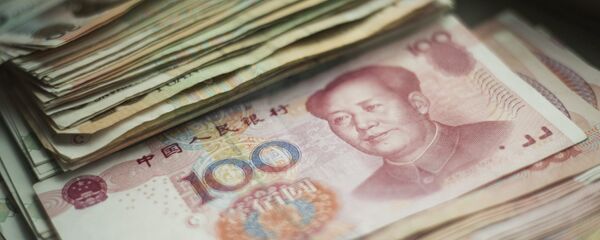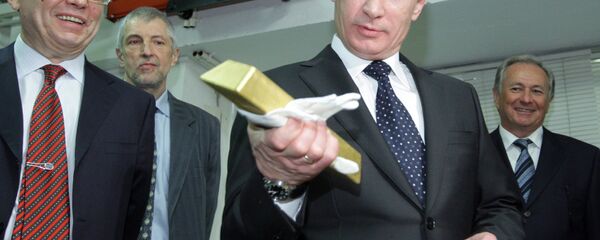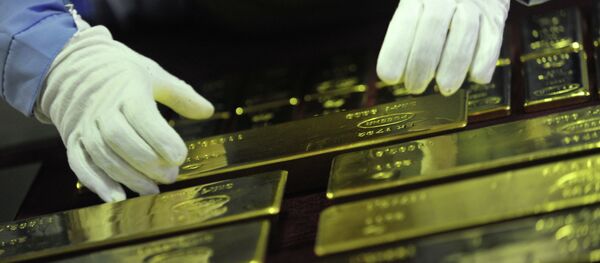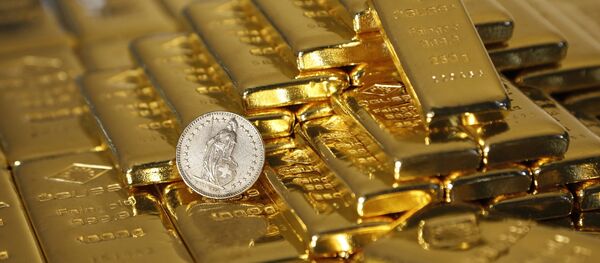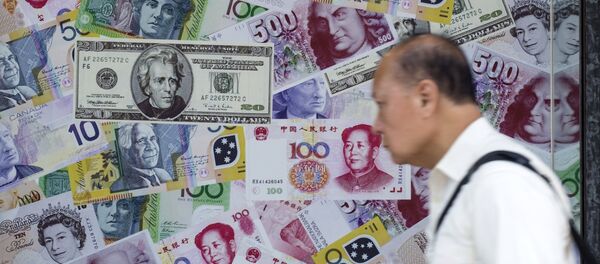According to the the Bank of Russia, the Chinese currency accounted for 15 percent of total holdings at the last reading, up from 5 percent at the end of the first quarter. That puts Russia's yuan share at about 10 times the average for global central banks, with its total holdings of the currency accounting for about a quarter of world reserves in yuan, Bloomberg has reported.
Sputnik has discussed the issue with Luke Gromen, founder of unique macroeconomic research firm Forest for the Trees (FFTT); Madalina Sisu Vicari, managing director of Vocal Europe; and Ben Aris, editor-in-chief of Business News Europe.
Sputnik: The share of Russian reserves placed in CNY increased from 5 to almost 15 percent. What economic benefits will Russia get from these changes?
Luke Gromen: Shifting a greater percentage of FX [foreign exchange] reserves to CNY brings Russia’s FX reserve balances into greater alignment with actual Russian trade flows (i.e. as Russia trades more with China, it makes more sense to keep a greater percentage of FX reserves in CNY.)
Yet, it is premature to assess the economic benefits of such a situation; most likely, the Petro-CNY system, which has been already working for a while, will be enhanced. However, what is pretty clear is the following aspect: by ditching the dollar and shifting towards other currencies, Russia is reducing the risk of leverages that might be used against it, especially from geopolitical perspective.
Ben Aris: Russia is beginning a long process of moving away from the dollar as the international setllement currency. Since the end of WWII, the dollar has become a de facto global reserve currency that has been used to settle international trade deals. This gives it a stability and liquidity that no other currency can match.
As a result, it has also become a “store of value,” which makes it unique but also gives the USA a tool of foreign policy that no other country has — its ability to manipulate and control the supply of dollars that affect the greenback’s value.
However, Russia (and increasingly China) want to move to setting their trade in their national currencies. Sino-Russian trade turnover just topped $100 billion for the first time in December, up from around $5 billion of mutual trade in 1991, and both countries have begun to settle their mutual trade in their own currencies. In 2008 the share of RMB/RUB settlements in mutual trade was zero, and now it makes up about a quarter. This means that Russia needs a store of RMB to provide the liquidity to cover this mutual trade settlement process. Increasing the share of RMB in the gross inernational reserves (GIR) is the store needed.
Luke Gromen: I would not call ~11 percent growth in five years “rapid” per se. I would expect the statistics to continue growing in the next five years, dependent on a number of potential variables including Russian economic growth, Chinese economic growth, One Belt One Road progress, etc.
Madalina Sisu Vicari: This turnover is an all-time high, and though a “rapid growth,” it is not an “unexpected” one, because it reflects the political and economic rapprochement between the two countries, Russia and China. It also reflects the growing cooperation in a series of important sectors: energy (oil and gas), military industry, a wide array of business synergies – i.e. common strategic projects in transport, technology and infrastructure sectors.
Also, the bilateral trade settled in CNY between Russia and China may be extended to other areas (natural gas, big infrastructural projects with joint participation, agricultural products, etc.), and that could facilitate and ultimately further boost the trade turnover between the two countries.
Ben Aris: It has been steady but not rapid. This target of $100 billion was set several years ago. However, in the economic slowdown that followed the 2014 oil price crash, the growth of trade went backwards for at least two years, getting stuck at about $60 billion to $70 billion. Trade turnover only started growing again in 2016 when the “silent crisis” caused by the devaluation associated with the collapse of oil prices came to an end.
Last year a new target of bringing mutual trade to $200 billion by 2020 was set, and that is the goal now.
Luke Gromen: Over time, assuming certain circumstances, it is theoretically possible. In addition to shifting FX reserves composition (which is underway), Russia would also have to shift pricing of exports to other currencies (EUR, CNY) – however, this will have to be managed gradually due to existing levels of USD-denominated debt in the Russian private sector, so as not to cause too severe USD shortages (too severe RUB/USD weakness) in the private sector during the transitional period.
Madalina Sisu Vicari: Following a broad shift pursued in the second quarter of last year, currently only 22 percent of Russia’s $485 billion reserves are kept in dollars. Hence, we cannot speak, literally, about a “dependence” on the dollar. What Russia can do, if it considers that it is in its interest, is to speed up the de-dollarization of its economy. For that, it needs to accelerate and stimulate the transactions in other currencies than dollars (euros for transactions with the EU; CNY for transactions with China; roubles for transactions with countries of EEU/CIS); increase euro and gold reserves; and de-list Russian companies from foreign stock exchanges. However, the de-dollarization won’t be done overnight; it depends on close cooperation with other countries, and it needs time and political willingness in order to be achieved.
Ben Aris: It will take years to get rid of the dollar — if then.
Part of the problem is that the international market for oil is still largely settled in dollars, and this is one of Russia’s most important export products.
There has been an attempt to set up a commodities exchange in St. Petersburg to trade oil and oil futures in RUB, but it has not made much progress. Until you can buy oil on the international markets in a currency other than USD, Russia will never be able to ditch the USD completely.
Sputnik: Could rejection of the dollar and the purchase of yuan expand the use of the Russian rouble in foreign trade settlements?
Luke Gromen: In my opinion, expanded use of the rouble in foreign trade settlements is unlikely in the near term, however, continued improvement in Russia’s external foreign debt position and relative gold holdings may serve to gradually improve the international standing of the RUB with certain trade partners in coming years.
Sputnik: There have been several precedents when the US has frozen the assets of central banks: the US froze tens of billions of dollars from the Iranian Central Bank, as well as several billion from the Central Bank of Libya in March 2011. Should we expect such measures in relation to the Central Bank of Russia? What counter measures could the US take? Should we expect a new package of anti-Russian sanctions?
Luke Gromen: It seems possible the US could introduce new sanctions on Russia; it is unclear to me if such sanctions could be introduced on the Central Bank of Russia, what the implications of such sanctions would be or if such new sanctions (on Russia or the Russian Central Bank) are being considered by the US.
Madalina Sisu Vicari: A freeze of assets in relation to the Central Bank of Russia by the United States seems, at this moment, unlikely. That would require for the current sanctions’ architecture against Russia to be widely expanded, on one hand, and it would be a strong political signal that would indicate that the United States, especially the current administration, aims to move to a new phase, more antagonistic than the current one, in its relation with Russia, on the other hand.
However, it should be taken into account the degree of unpredictability of domestic developments and Congressional pressure, and in this regard should be mentioned DASKAA and DETER, which may impose harsh sanctions. In order to maximize their impact, so far most of the economic sanctions against Russia were coordinated between the US and its allies, the EU notably.
That will clearly not be the case if the United States unilaterally imposes sanctions related to the Nord Stream 2 pipeline project. Moreover, it remains to be seen if the EU will preserve its willingness for further coordination of sanctions with the US.
Ben Aris: This would be destabilizing for everyone, as the point of buying US Treasury bills is they are supposed to be the least risky asset in the world. This is partly because so many dollars are held outside of the US, so there is always a liquid market even if the US itself is closed.
However, clearly the CBR is worried about possible freezing of US assets, such as Russian-owned Treasury bills, and in 2018 moved to dramatically reduce the amount of Treasury bills it holds. As it turns out, it has not sold all the Treasury bills it holds, but it has moved a large amount of them offshore to tax havens — putting them beyond the reach of the US Treasury Department's ability to sanction them.
As the US itself is so in debt and relies so heavily on Treasury bills to finance its own deficit, it can’t issue a blanket freeze on its own bills, as it would cripple the US economy, so moving these bills offshore gives some measure of protection.
As for new sanctions in 2019: these are highly likely. Those imposed in 2014 were largely symbolic: visa bans on military personnel and politicians directly involved in the annexation of Crimea.
In 2019 we can expect the escalation to continue, and it's likely they will go further, targeting financial instruments more aggressively. Specifically, Russian sovereign debt — both the international eurobonds and the domestic treasury bills, the so called OFZ — are now in the cross hairs.
However, it remains unlikely that these bonds will be targeted, as they are so widely held, including by US investors like pension funds and insurance funds. So any pain inflicted on Russia would boomerang back on US investors — similar to how the attempt to sanction Rusal bounced back on western investors in the form of high costs of aluminum that hurt European business.
Sputnik: The chief investment strategist of BCS Financial Group, Maxim Shein, believes that one of the reasons the Central Bank reduced American assets is the gradual decrease in the influence of the US dollar as the main reserve and settlement currency. How do you see the fate of the dollar on the world market?
Luke Gromen: In 2014, Vladimir Putin said the USD’s monopoly in energy trade was damaging the Russian economy and announced moves to increase Russian energy trade in currencies other than the USD.
I think there is a quiet battle being waged globally regarding the USD’s longstanding monopoly on the pricing of energy specifically and commodities more broadly. It appears that the USD’s monopoly is being broken in part due to economic reality (China is now the biggest energy importer, the EU's desire for more control over their own energy bill) and in part due to geopolitical tensions (repeated US weaponization of the USD.)
As the USD’s monopoly on global commodity markets is broken, I would initially expect to see the USD rise and commodities fall for a period of time. This has been happening since 3q14 [third quarter 2014], and as such, the USD's strength seen since 2014 is a bit misleading, in my view.
Madalina Sisu Vicari: As it was mentioned above, in my opinion, the Central Bank diminished its assets in dollars as a move aimed at reducing the risk of leverages that might be used against Russia.
The dollar’s importance on the world market will continue to decline, but the dollar's demise as global reserve and trade currency will not occur too soon. Unless a cataclysmic shift occurs in the international financial system, but that seems, if not almost impossible, at least highly unlikely.
Ben Aris: The problem with getting rid of your dollar holdings is if you sell, the price goes down. A country like China holds trillions in Treasury bills, so if it sells, the value of its own reserves will fall by many billions of dollars in value, as you would create a glut of USD bills, and no one is in the position to pick up the excess.
So no country is going to do that — or at least not quickly. In Russia’s case, it was not as bad, as it sold only $100 billion worth of bills in a market with many trillions of liquidity. It caused prices of these bonds to fall, but that only lasted a few days until the market absorbed the new supply. But everyone cannot sell at once.
If the majority of countries want to unload their USD holdings, the only way they can do it is extremely slowly, so that the market can absorb the new supply. And that will take years, if not decades, if not a generation.
Sputnik: Most global payment systems are tied to the dollar. What currency will lead the global payment systems in the future?
Luke Gromen: In my opinion, the USD will be first among a couple regional equals in the coming years (EUR, CNY) after a shift to multi-currency energy pricing (now underway), followed by a restructuring of the USD’s global reserve status that separates the USD’s medium of exchange function from its store of value function (USTs will no longer be global primary reserve asset), shifting the store of value (reserve asset) function to a neutral reserve asset like gold, or potentially IMF SDR’s, crypto assets or perhaps some combination of the three.
Ben Aris: At the end of the day these international reserves are used to settle international trade deals. The reserve money has to have a use, as it needs a demand if it is to hold its value.
So the currencies that could replace the USD are those belonging to countries with a big volume of trade. The EUR is 20 years old this December, and the volumes of trade in the EU are enormous — on par with the US trade, as there is so much internal EU trade on top of EU-rest of the world trade.
So that currency is already a big and important reserve currency. China’s RMB is also already a big player in trade, but it has been unpopular, as the Chinese have kept the value artificially low for many years. But now that China has changed from an export-driven growth model to an internal domestic consumption model, the value of the RMB will start to better reflect its true worth, and the size of the volumes of China’s trade make it another candidate.
The other currencies are less important.
YEN and GBP already feature in some CB currency baskets, but in single percents; but that is how it should be, as trade with these countries is in the same proportion as a share of overall trade.
Indeed, Russia will never entirely move away from holding the dollar, as it will always have some trade with the USA (and oil will continue to be priced in USD for the foreseeable future) and so needs to hold dollars in proportion to the trade turnover it has with the USA (oil).
Views and opinions expressed in this article are those of the speakers and do not necessarily reflect those of Sputnik.

